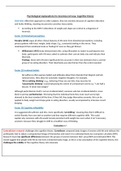Psychological explanations for Anorexia nervosa: Cognitive theory
Overview: Alike their approach to other subjects, they see anorexia because of cognitive distortion
and faulty thinking, meaning we perceive ourselves inaccurately.
According to the DSM-5 distortions of weight and shape are central to a diagnosis of
Anorexia.
Factor (1) Disturbed perceptions
Murphy (2010) argue all other clinical features of AN stem from disturbed perceptions, including
preoccupations with food, weight, body shape. E.g., constantly looking in the mirror. They
misinterpret their emotional state as ‘feeling fat’ even as they get thinner.
Williamson (1993) study demonstrates this: using silhouettes to match to participants own
body, participants with AN were asked to estimate their current body size and indicate their
ideal size,
Findings: those with AN were significantly less accurate in their size estimates than a control
group of no eating disorders. Their ideal body was also thinner than the control wanted.
Factor (2) Irrational beliefs
AN sufferers often express beliefs and attitudes about their disorder that illogical and lack
rational sense, they allow for automatic negative thoughts. For example,
‘All or nothing thinking’: e.g., believing if they are not thin, they must be fat
‘Catastrophic thinking’: overemphasising the extent of unimportant events e.g. “I ate half a
biscuit; I’ll never lose weight”
Although perfectionism itself is not an irrational belief, someone who has irrational beliefs is more
likely to portray perfectionism. This being that the individual feels they must reach every high
demand to the best standard all the time, if they fail, they judge themselves severely, this can be
applied to body weight and shape goals in eating disorders, usually accompanied by intensive record
keeping.
Factor (3) Cognitive inflexibility
It is suggested AN sufferers lack this, more specifically ‘set shifting’, meaning they find it difficult to
switch fluently from one task to another task that requires different cognitive skills. This could
explain why someone with AN would remain persistent with weight loss even when it isn’t necessary
anymore, because they struggle to shift to a healthier way of thinking.
Evaluation +/-
Contradictory research challenges the cognitive theory. Cornelissen compared body images of women with AN and without AN,
participants had to adjust a computerised image of themselves and match it to estimated body size (computer calculates BMI).
Research found no significant differences between the groups of women between their actual BMI and estimated BMI. This
would suggest that people with AN do not have a distorted body image, as this is a key assumption of the cognitive theory, this
challenges the validity of the cognitive theory into Anorexia.





